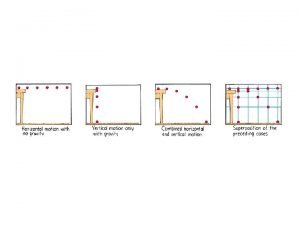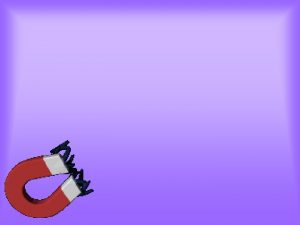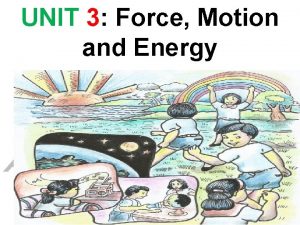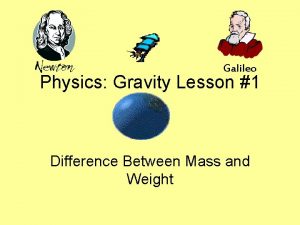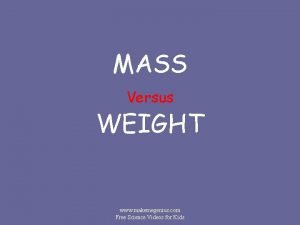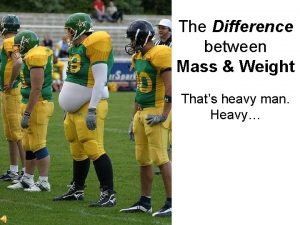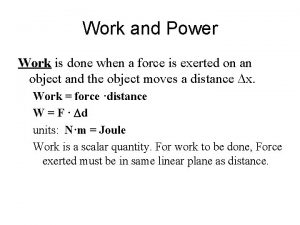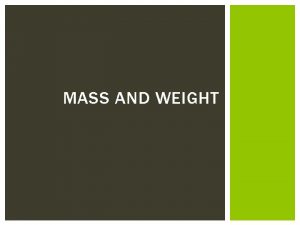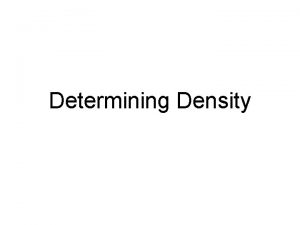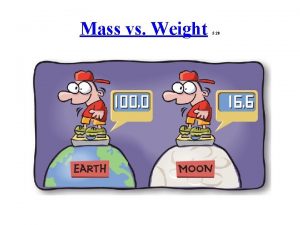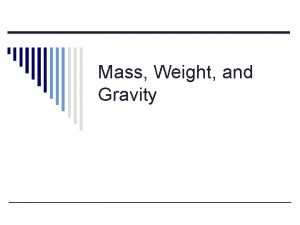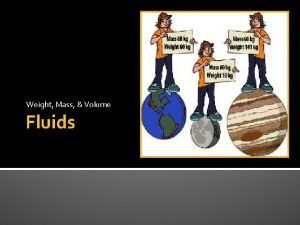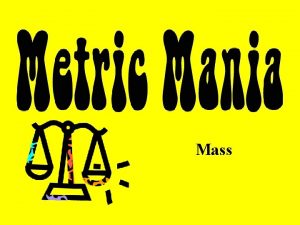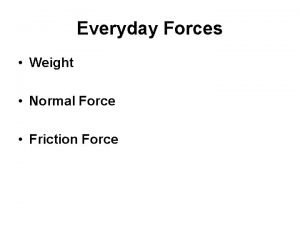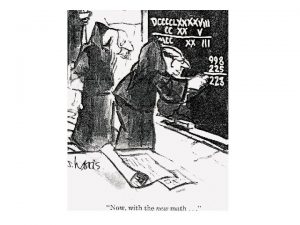Weight and Mass Weight The force pulling down












- Slides: 12

Weight and Mass

Weight – The force pulling down on an object created by earth’s gravity (9. 8 m/s 2) Weight is a FORCE Therefore, units = NEWTONS (N) Your Weight will be different on Earth and Mars Earth’s gravity = 9. 8 m/s 2 Moon’s gravity = 1. 6 m/s 2

Calculating Weight Formula: Force Weight = Mass * Gravity Symbols Units Fw = m * g (N ) = (kg) (m/s 2) Remember to use Newtons NOT Pounds since we are Scientific. (1 N = 2. 2 lbs) Look Familiar? Formula: Force Weight = Mass * Accel due to Gravity Symbols Formula: Fw Force = m * g = Mass * Accel

Calculating Weight Example: If you have a mass of 22 kg on Earth (9. 8 m/s 2), what is your weight? Fw = 22 kg * 9. 8 m/s 2 Fw = 215. 6 kg*m/s 2 Fw = 215. 6 N If you have a mass of 22 kg on Mars (with 1/3 the gravity of Earth), what is your weight? Fw = 22 kg * ((9. 8 m/s 2) * (1/3)) Fw = 22 kg * 3. 27 m/s 2 Fw = 71. 94 kg*m/s 2

Mass – amount of matter that makes up an object. Units = kg Your Mass will be the same on Earth or Mars. You have the same amount of matter everywhere.

Weight vs. Mass Weight is measure of the force of gravity acting on your mass Weight will be different everywhere Units = N (because it is a FORCE) Mass is the same everywhere, regardless of gravity Mass will always remain the same Units = kg

Friction If gravity is always pulling us down (or if we are moving) we are always going to be in contact with something. Friction is a force that results from the relative motion between objects AKA: The force that works against and slows motion because the surface of any object is rough

Friction Some friction is useful Walking (friction between ground and foot) Driving (friction between ground and tire) Brakes (friction between brake pad and the disc (attached to wheel) Writing (friction between paper and pen/pencil) Throwing (friction between hand ball) Some friction is unwanted Overheating in a machine/engine is caused by friction Any moving that slows down when it is not wanted Friction makes moving heavy objects much harder

Multiple Forces Acting At Once There will always be MORE than 1 force acting on an object at a time. Net force = total of all forces There are 2 options: Balanced forces Equilibrium = all forces on an object are balanced and no change in movement occurs Unbalanced forces Net forces do not equal zero Motion will occur in the direction of the Net Force

Free Body Diagrams - HONORS There is a box on the table. What forces are acting on this box? Weight Gravity pulling down on the box Normal Force Table pushing up What other forces can act on the box? Push to the right (or pull from the

Free Body Diagrams - HONORS Identify the value for: Force of Weight: Normal Force: Friction Coefficient: “Push”: Is this box moving? If so, which direction and with what unbalanced force?

Free Body Diagrams - HONORS This can be shown 2 different ways: Arrows pointing towards the center of the object Arrows originating from the center of the object.
 A car of mass 1400kg pulling a trailer of mass 400 kg
A car of mass 1400kg pulling a trailer of mass 400 kg Pulling down the wall of jericho
Pulling down the wall of jericho An invisible pulling force
An invisible pulling force The act of pushing and pulling of a magnet is called
The act of pushing and pulling of a magnet is called Biomechanics of pushing and pulling
Biomechanics of pushing and pulling Bulk-gaining and bulk-reducing examples
Bulk-gaining and bulk-reducing examples I fled him
I fled him Difference between weight and mass
Difference between weight and mass Difference between weight and mass
Difference between weight and mass Is weight mass or volume
Is weight mass or volume Mass vs wieght
Mass vs wieght Do heavier objects fall faster
Do heavier objects fall faster Work vs power
Work vs power
